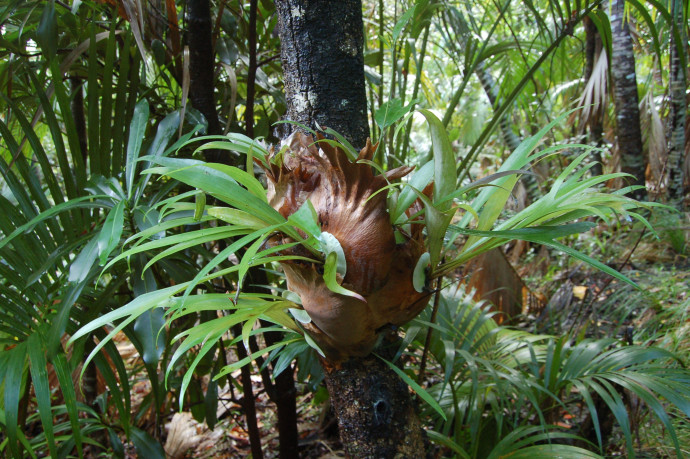Research
Published 4 September 2023The sophisticated social life of staghorn ferns

Staghorn ferns have adapted to life in the trees by forming co-operative colonies - could this be the first example of a eusocial plant?
Many animals have taken advantage of the benefits of living together in groups, but the most sophisticated form of group living is observed in “eusocial” animals. Eusociality has evolved multiple times independently, most famously in the social insects (bees, wasps, ants and termites), but also in some shrimp and mole rats. It is characterised by division of labour between members of a colony (for example, worker and soldier castes), and by multiple generations of colony members forgoing reproduction to look after the offspring of one or a small number of ‘queens’. Although eusociality appears to be a very successful strategy for a number of animals, there have until now been no convincing examples of eusociality in plants.
Professor Burns, an evolutionary ecologist working at Te Herenga Waka Victoria University of Wellington, and co-investigators Professor Vincent Savolainen (Imperial College London) and Mr Ian Hutton (Lord Howe Island Museum), have been attempting to change this by investigating the life history of the staghorn fern (Platycerium bifurcatum). This unusual Australasian native usually grows without soil on the branches of rainforest trees, where water and nutrients may be scarce. Staghorn ferns seem to have solved this problem by living together in colonies with striking similarities to those of eusocial animals.
A staghorn fern colony may contain more than 50 individual ferns. Each is anchored to the colony by its “nest” fronds (which dry to a papery brown as they age) and extends elongated “strap” fronds outwards to gather sunlight for photosynthesis and to produce spores for reproduction. Through their field work on Lord Howe Island, Professor Burns and his team have shown that individual colony members differ markedly in the number, form and function of their fronds depending on their position in the colony. For example, those at the top form waxy, fan-shaped nest fronds that collect water and channel it downwards into the colony, while those at the bottom form spongy nest fronds that absorb excess water and store it for later use. Stored water can be distributed between individual colony members when needed thanks to an extensive shared root system. Furthermore, individuals at the top of the colony have more reproductively-active strap fronds than those at the bottom, and 40% of colony members do not appear to contribute to reproduction at all. This dramatic division of labour between individual ferns resembles what is observed in eusocial animals.

Lord Howe Island, where Professor Burns and his team are carrying out fieldwork on staghorn ferns. Photo: supplied.
How do non-reproductive colony members benefit from this arrangement? As it turns out, most staghorn fern colonies are made up of genetically identical individuals. This means that non-reproducing individuals can spread their genes, and increase their evolutionary fitness, by supporting reproductive colony members. Similar benefits promote eusociality in animals, where colony members tend to be close relatives.
The scientific definition of eusociality is nuanced and sometimes controversial, but staghorn ferns seem to meet at least some of the expectations of “primitive” eusociality. Research is ongoing to better understand the parallels between staghorn fern and eusocial animal colonies – if these plants truly are eusocial, this would represent a major milestone in our understanding of plant complexity.
RESEARCHER
Professor KC Burns
ORGANISATION
Te Herenga Waka Victoria University of Wellington
FUNDING SUPPORT
Marsden Fund
CONTRACT OR PROJECT ID
VUW2003: Eusociality in plants
